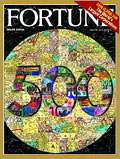Fortune 500
The Fortune 500 is an annual list compiled and published by Fortune magazine that ranks 500 of the largest United States corporations by total revenue for their respective fiscal years.[1] The list includes publicly held companies, along with privately held companies for which revenues are publicly available. The concept of the Fortune 500 was created by Edgar P. Smith, a Fortune editor, and the first list was published in 1955.[2][3] The Fortune 500 is more commonly used than its subset Fortune 100 or superset Fortune 1000.[4]

History
The Fortune 500, created by Edgar P. Smith, was first published in 1955.[2] The original top ten companies were General Motors, Jersey Standard, U.S. Steel, General Electric, Esmark, Chrysler, Armour, Gulf Oil, Mobil and DuPont.[5]
Methodology
The original Fortune 500 was limited to companies whose revenues were derived from manufacturing, mining, and energy exploration. At the same time, Fortune published companion "Fortune 50" lists of the 50 largest commercial banks (ranked by assets), utilities (ranked by assets), life insurance companies (ranked by assets), retailers (ranked by gross revenues) and transportation companies (ranked by revenues). Fortune magazine changed its methodology in 1994 to include service companies. With the change came 291 new entrants to the famous list including three in the Top 10.[6] There is a lag in creating the list, so for example, the 2019 Fortune 500 is based on each company's financial years ending in late 2018 (most commonly, on December 31), or early 2019.
Influence
As of 2019, the Fortune 500 companies represent approximately two-thirds of the United States's Gross Domestic Product with approximately $13.7 trillion in revenue, $1.1 trillion in profits, and $22.6 trillion in total market value. These numbers also account for approximately 17% of the gross world product. The companies collectively employ a total of 28.7 million people worldwide, or 0.4% of the Earth's total population.[7]
See also
- 40 under 40 (Fortune Magazine)
- Fortune Global 500
- Fortune India 500
- Fortune 1000
- List of largest companies in the United States by revenue
- List of largest companies by revenue
- List of Fortune 500 computer software and information companies
- List of women CEOs of Fortune 500 companies
- Forbes Global 2000
- Total Fortune 1000 companies by urban area list
References
- "Fortune 500". Fortune. Retrieved 17 September 2019.
- "Edgar Smith, 69, Dies; Retired Time Executive". New York Times. 1989-10-12. Retrieved 1 March 2016.
- "1955 Full list". Fortune. Fortune 500. Retrieved 1 March 2016.
- Williams, Sean (2015-06-04). "Fortune 100: Everything You've Ever Wanted to Know About This Popular Annual Ranking". The Motley Fool. Retrieved 1 March 2016.
- "What happened to the first Fortune 500?". Fortune. Retrieved 2017-03-24.
- Groves, Martha (26 April 1995). "Service Now Counts with Fortune 500". Los Angeles Times. Retrieved 12 October 2017.
- Youn, Soo (16 May 2019). "Amazon cracks top 5 Fortune 500 companies as Walmart keeps top spot". ABC News. Retrieved 20 May 2019.